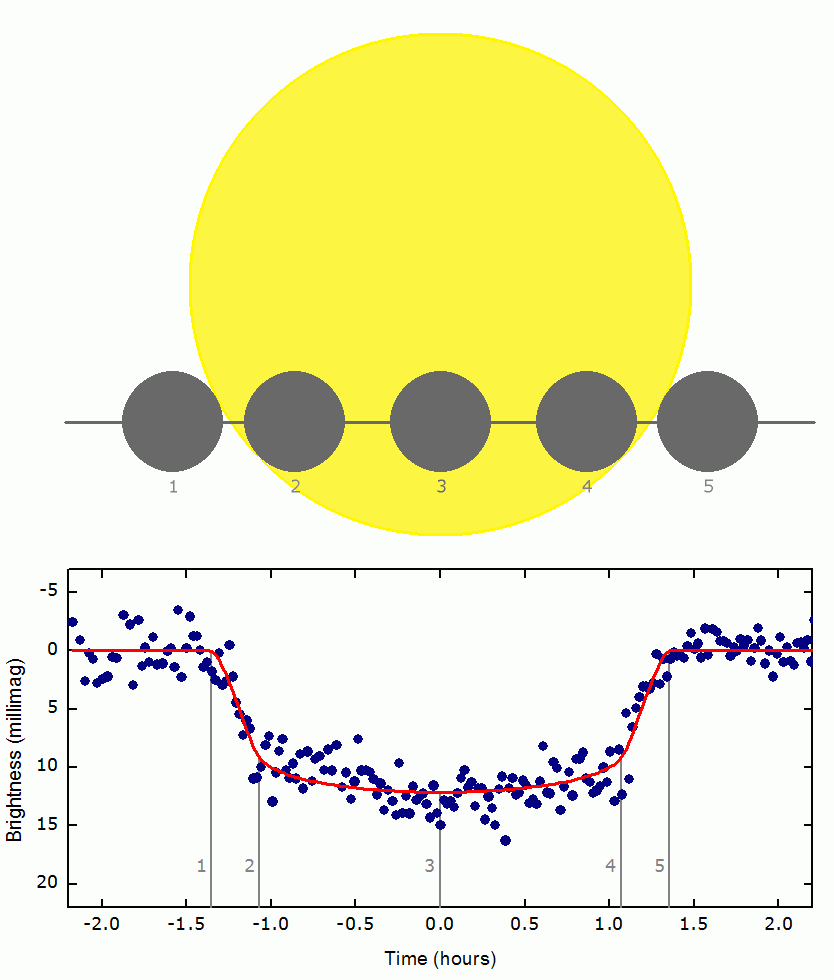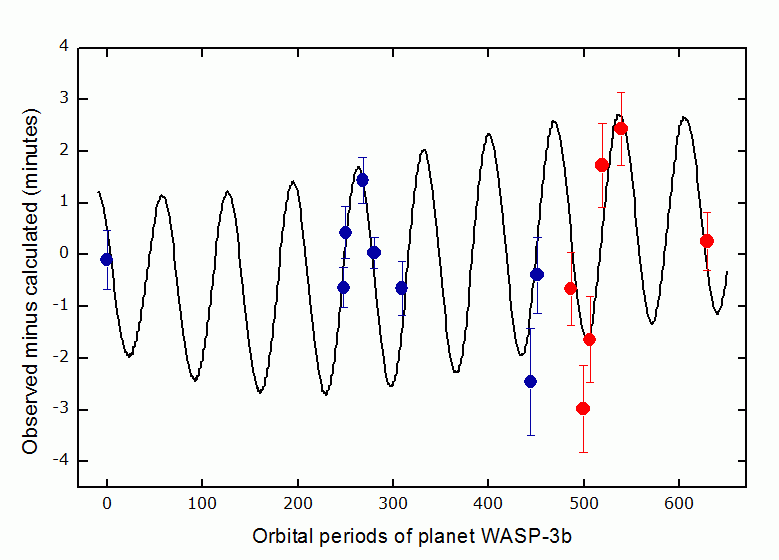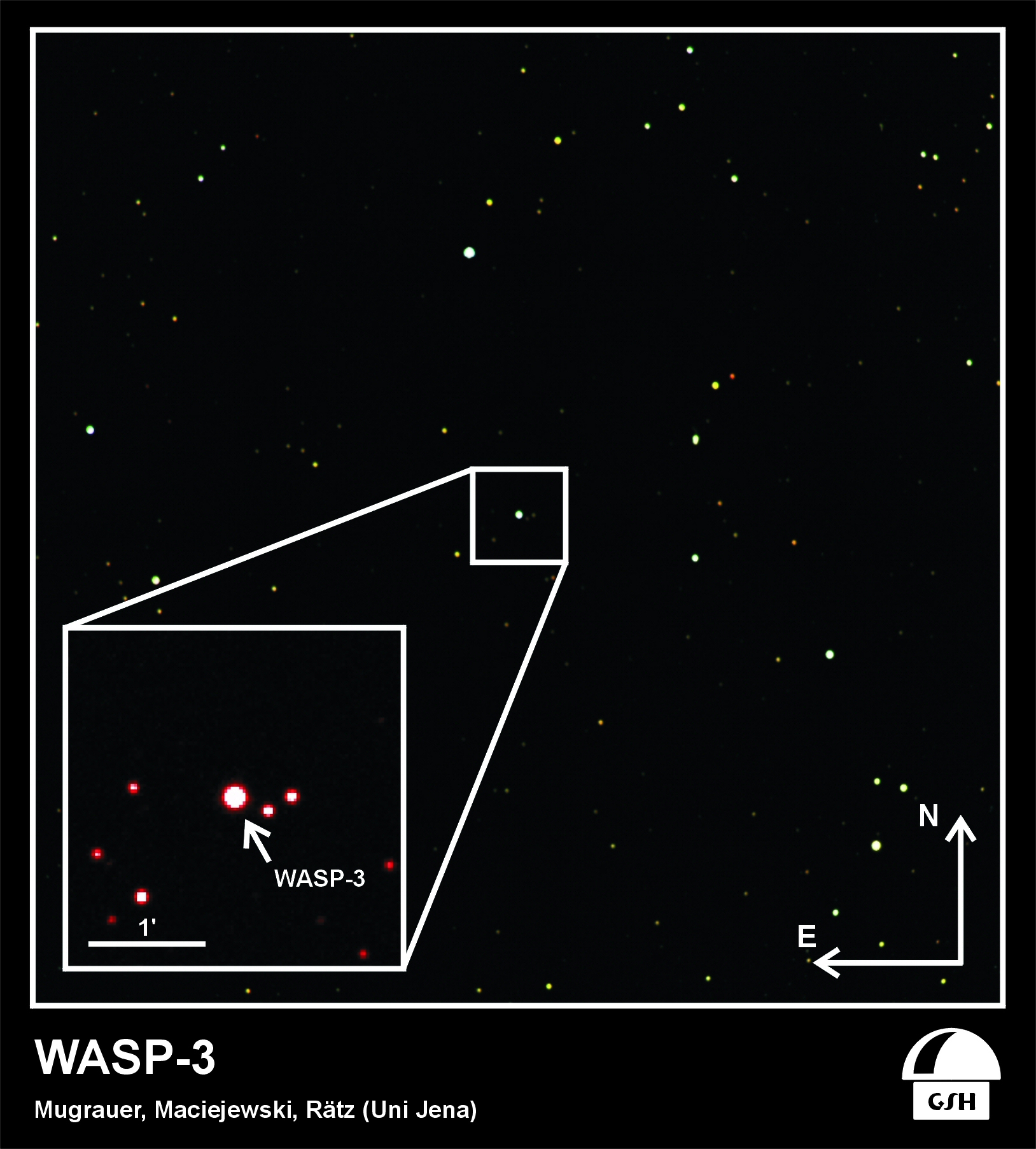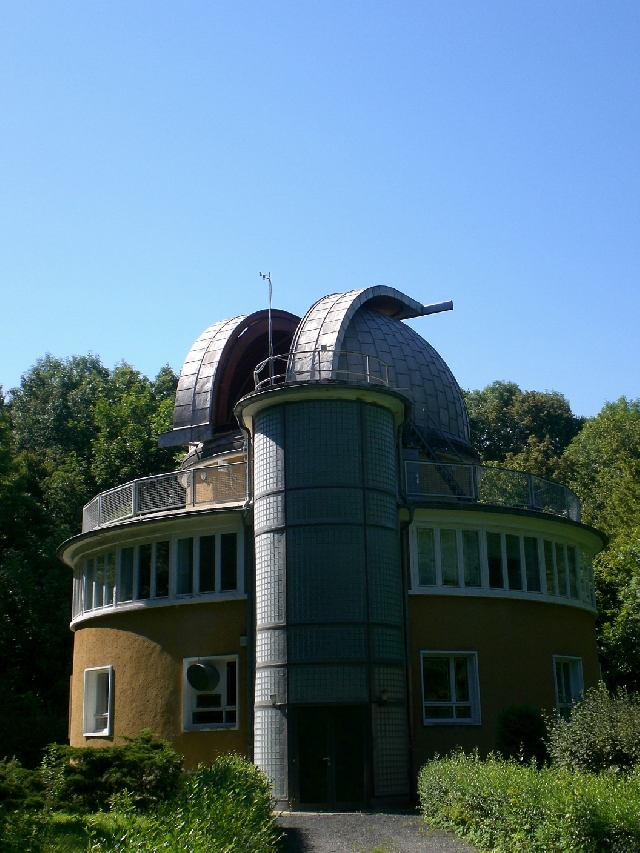 The bottom part of this figure shows our best light curve of the transit of the known planet WASP-3b obtained on 18 April 2010 with the University Observatory Jena 90-cm telescope. Individual data points with 25 or 30 seconds integration times are given as dots. We plot brightness of the star in milli magnitudes versus observing time in hours (0.0 for center of the transit). The red line is our best fit to the data showing the transit start (or ingress from first to second tick-mark), mid-transit (3rd tick-mark), and the transit end (or egress from the 4th to 5th tick-mark). During the ingress, the planet moves fully in front of the stellar disk and during the egress, the planet leaves the stellar disk. We have obtained six such transit light curves. The top part of this figure shows a drawing of the transit situation: The planet (dark circle) moves in front of the star (yellow circle) with ingress from position 1 to 2, mit-transit time at position 3, and egress from position 4 to 5.
The bottom part of this figure shows our best light curve of the transit of the known planet WASP-3b obtained on 18 April 2010 with the University Observatory Jena 90-cm telescope. Individual data points with 25 or 30 seconds integration times are given as dots. We plot brightness of the star in milli magnitudes versus observing time in hours (0.0 for center of the transit). The red line is our best fit to the data showing the transit start (or ingress from first to second tick-mark), mid-transit (3rd tick-mark), and the transit end (or egress from the 4th to 5th tick-mark). During the ingress, the planet moves fully in front of the stellar disk and during the egress, the planet leaves the stellar disk. We have obtained six such transit light curves. The top part of this figure shows a drawing of the transit situation: The planet (dark circle) moves in front of the star (yellow circle) with ingress from position 1 to 2, mit-transit time at position 3, and egress from position 4 to 5.
|
 This is the so-called O-C diagram. We plot the difference between observed (O) transit time and calculated (C) expected transit time on the y-axis in minutes versus the time given as orbital periods of the known planet WASP-3b. We plot the previously published transit times as blue dots and our own new measurements as red dots. If there would be only one planet around the star WASP-3, then all points should be on one straight line. If there would be a second planet with 15 Earth masses and 3.75 day orbital period (called WASP-3c), then this second planet would modify the orbital period of the first known planet (WASP-3b, 2 Jupiter masses in 2 day orbit) in such a way as shown by the black line, which we have calculated. This is the best fitting configuration, i.e. indirect evidence for such a new planet WASP-3c.
This is the so-called O-C diagram. We plot the difference between observed (O) transit time and calculated (C) expected transit time on the y-axis in minutes versus the time given as orbital periods of the known planet WASP-3b. We plot the previously published transit times as blue dots and our own new measurements as red dots. If there would be only one planet around the star WASP-3, then all points should be on one straight line. If there would be a second planet with 15 Earth masses and 3.75 day orbital period (called WASP-3c), then this second planet would modify the orbital period of the first known planet (WASP-3b, 2 Jupiter masses in 2 day orbit) in such a way as shown by the black line, which we have calculated. This is the best fitting configuration, i.e. indirect evidence for such a new planet WASP-3c.
|
 This is the a schematic model of WASP-3 planetary system. The central star (a) is located in the centre. The orbit of transiting planet WASP-10b (b) is located very close to the star - the year on this planet is only 1.84 day long. A new planet WASP-10c (c) has wider orbit and orbits the star within 3.75 day. Both planets are very close to a specific situation called by astronomers - orbital resonance. The orbital period of planet c is twice as the orbital period of planet b. The sizes of bodies are not to scale.
This is the a schematic model of WASP-3 planetary system. The central star (a) is located in the centre. The orbit of transiting planet WASP-10b (b) is located very close to the star - the year on this planet is only 1.84 day long. A new planet WASP-10c (c) has wider orbit and orbits the star within 3.75 day. Both planets are very close to a specific situation called by astronomers - orbital resonance. The orbital period of planet c is twice as the orbital period of planet b. The sizes of bodies are not to scale.
|
 This image shows the faint star WASP-3 (V=10.5 mag) in the center of the image (CCD camera GSH CTK).
The star and its immediate surrounding with a few background stars is enlarged with better sensitivity and resolution (CCD camera GSH STK) in the inlay in the lower left. The star has a distance of 700 light years
and is located in the constellation Lyra. North is up, east to the left. The scaling of
1 arc min is shown in the inlay; the scale of the large image is 32 arc min at a side.
The large image is a composite of three images taken at different wavelength (blue, visual, red),
the small inlay only in the red, as all our transit observations with the 90-cm telescope of the
University Observatory Jena. The transit observations were obtained in Jena with the new CCD camera called Schmidt Telescope Kamera (STK).
This image shows the faint star WASP-3 (V=10.5 mag) in the center of the image (CCD camera GSH CTK).
The star and its immediate surrounding with a few background stars is enlarged with better sensitivity and resolution (CCD camera GSH STK) in the inlay in the lower left. The star has a distance of 700 light years
and is located in the constellation Lyra. North is up, east to the left. The scaling of
1 arc min is shown in the inlay; the scale of the large image is 32 arc min at a side.
The large image is a composite of three images taken at different wavelength (blue, visual, red),
the small inlay only in the red, as all our transit observations with the 90-cm telescope of the
University Observatory Jena. The transit observations were obtained in Jena with the new CCD camera called Schmidt Telescope Kamera (STK).
|
 The University Observatory Jena with its 90-cm telescope in Grossschwabhausen near Jena,
where 3 of the 6 new transits of WASP-3b were observed with a new CCD camera. The University Observatory Jena with its 90-cm telescope in Grossschwabhausen near Jena,
where 3 of the 6 new transits of WASP-3b were observed with a new CCD camera. |
An additional component to the extrasolar transiting planetary system WASP-3, a 15 Earth mass planet was detected by an international team of astronomers led by Dr. Gracjan Maciejewski of Jena University. This is the first planet detected with the new technique called Transit Timing Variations.
"We detected periodic variations in the transit timing of WASP-3b. We found that the amplitude of these variations can be explained by an additional planet in the system, with a mass of 15 Earth-mass (i.e. one Uranus mass) and period of 3.75 days." - Dr. Maciejewski said, "According to international rules, we call this new planet WASP-3c". This newly discovered planet is among the least massive planets known to-date and also the least massive planet known orbiting a star which is more massive than our Sun. The host star WASP-3 is also younger than our Sun.
This is the first time, that a new extra-solar planet is discovered by this method. This technique is an indirect detection technique, such as the previously successful radial velocity and transit techniques themselves.
This is already a second planet in the system. It is much smaller than the one originally discovered of 2 Jupiter masses (about 630 Earth masses). The discovery of the second, 15 Earth mass planet makes the system very intriguing. The new planet, appears to be trapped in external orbit, twice longer than the orbit of the more massive planet. Such a configuration is probably a result of early evolution of the system.
"There are only some 80 planets, of about 450 extra-solar planets and planet candidates discovered so far around other stars, which orbit their stars in the plane of our line-of-sight, so that we can observe how the stars dim slightly (typically about 1 per cent) when the planet transits in front of the stellar disk. One of those transiting planets is WASP-3b, at a distance about 700 light years, in the constellation Lyra, which is known to host a hot-Jupiter type planet with less than 2 day orbital period." - Prof. Ralph Neuhäuser explains.
"In 2008, we started our observing campaign to search for such Transit Timing Variations in selected transiting exoplanets." - Dr. Maciejewski said. "We observed six new transits of the known planet WASP-3b, three with the 90-cm telescopes of the University Observatory Jena operated by the Astrophysical Institute of the Friedrich Schiller University and three with the 60-cm telescope of the Rozhen National Astronomical Observatory operated by the Institute of Astronomy, Bulgarian Academy of Sciences." On the Jena telescope, a new CCD detector was used, installed partly for this project in the telescope's so-called Schmidt focus (60-cm effective mirror), which was supported by the Thuringian science ministry.
"We are currently observing the new planet also by radial velocities with the 10-meter Hobby-Eberly-Telescope in Texas to get additional evidence for our finding." - Prof. Andrzej Niedzielski said. The new planet should be detectable by both radial velocity as well as own transit observations, which we will try to perform in order to finally confirm the existence of this new planet.
The new technique for discovering additional planets around transiting planets host stars, Transit Timing Variation, was suggested a few years ago. In a single-planet extra-solar transiting system, a planet orbits its host star on a Keplerian orbit and transits occur at equal time intervals, the orbital period. If there is another (not necessarily transiting) planet in the system, it interacts gravitationally with the transiting planet and generates deviations from the strictly Keplerian case. Hence the name of the method. From the period and amplitude of the variations, one can derive the parameters of the perturbing planet by comparing observations with tens of thousands of configurations of various planetary systems calculated with a computer.
The transit timing variation (TTV) method is very attractive, because it is particularly sensitive to small perturbing planets, even down to few Earth masses. E.g., a one Earth-mass planet perturbing a typical hot-Jupiter gas giant is expected to cause deviations in transit timing up to 1 minute. This effect can be detected by 1-meter class telescopes. The search for planets with this technique is one of main topics of German-Polish scientific cooperation funded by DAAD and Polish Ministry of Science and Higher Education; on the Jena side, it is also supported by the European Union through a Marie-Curie project.
The paper describing the discovery has been accepted for publication by the typical peer review system in the international high-standard astrophysical journal called Monthly Notices of the Royal Astronomical Society (London, UK). The research is a cooperation between Astrophysical Institute of the Friedrich Schiller University in Jena, Germany, the Institute of Astronomy of the Bulgarian Academy of Sciences in Sofia, Bulgaria, and the Torun Centre for Astronomy of the Nicolaus Copernicus University in Torun, Poland. The research was led by Jena post-doc Dr. Gracjan Maciejewski, originally from Torun, Poland. The full paper can be found at http://xxx.lanl.gov/abs/1006.1348. The authors of the paper are Gracjan Maciejewski (Jena), Dinko Dimitrov (Rozhen), Ralph Neuhäuser (Jena), Andrzej Niedzielski (Torun), Markus Mugrauer (Jena) as well as several Jena PhD and Diploma students (Stefanie Raetz, Christian Ginski, Christian Adam, Claudia Marka, and Mohammad Moualla).
 The bottom part of this figure shows our best light curve of the transit of the known planet WASP-3b obtained on 18 April 2010 with the University Observatory Jena 90-cm telescope. Individual data points with 25 or 30 seconds integration times are given as dots. We plot brightness of the star in milli magnitudes versus observing time in hours (0.0 for center of the transit). The red line is our best fit to the data showing the transit start (or ingress from first to second tick-mark), mid-transit (3rd tick-mark), and the transit end (or egress from the 4th to 5th tick-mark). During the ingress, the planet moves fully in front of the stellar disk and during the egress, the planet leaves the stellar disk. We have obtained six such transit light curves. The top part of this figure shows a drawing of the transit situation: The planet (dark circle) moves in front of the star (yellow circle) with ingress from position 1 to 2, mit-transit time at position 3, and egress from position 4 to 5.
The bottom part of this figure shows our best light curve of the transit of the known planet WASP-3b obtained on 18 April 2010 with the University Observatory Jena 90-cm telescope. Individual data points with 25 or 30 seconds integration times are given as dots. We plot brightness of the star in milli magnitudes versus observing time in hours (0.0 for center of the transit). The red line is our best fit to the data showing the transit start (or ingress from first to second tick-mark), mid-transit (3rd tick-mark), and the transit end (or egress from the 4th to 5th tick-mark). During the ingress, the planet moves fully in front of the stellar disk and during the egress, the planet leaves the stellar disk. We have obtained six such transit light curves. The top part of this figure shows a drawing of the transit situation: The planet (dark circle) moves in front of the star (yellow circle) with ingress from position 1 to 2, mit-transit time at position 3, and egress from position 4 to 5.
 This is the so-called O-C diagram. We plot the difference between observed (O) transit time and calculated (C) expected transit time on the y-axis in minutes versus the time given as orbital periods of the known planet WASP-3b. We plot the previously published transit times as blue dots and our own new measurements as red dots. If there would be only one planet around the star WASP-3, then all points should be on one straight line. If there would be a second planet with 15 Earth masses and 3.75 day orbital period (called WASP-3c), then this second planet would modify the orbital period of the first known planet (WASP-3b, 2 Jupiter masses in 2 day orbit) in such a way as shown by the black line, which we have calculated. This is the best fitting configuration, i.e. indirect evidence for such a new planet WASP-3c.
This is the so-called O-C diagram. We plot the difference between observed (O) transit time and calculated (C) expected transit time on the y-axis in minutes versus the time given as orbital periods of the known planet WASP-3b. We plot the previously published transit times as blue dots and our own new measurements as red dots. If there would be only one planet around the star WASP-3, then all points should be on one straight line. If there would be a second planet with 15 Earth masses and 3.75 day orbital period (called WASP-3c), then this second planet would modify the orbital period of the first known planet (WASP-3b, 2 Jupiter masses in 2 day orbit) in such a way as shown by the black line, which we have calculated. This is the best fitting configuration, i.e. indirect evidence for such a new planet WASP-3c.
 This is the a schematic model of WASP-3 planetary system. The central star (a) is located in the centre. The orbit of transiting planet WASP-10b (b) is located very close to the star - the year on this planet is only 1.84 day long. A new planet WASP-10c (c) has wider orbit and orbits the star within 3.75 day. Both planets are very close to a specific situation called by astronomers - orbital resonance. The orbital period of planet c is twice as the orbital period of planet b. The sizes of bodies are not to scale.
This is the a schematic model of WASP-3 planetary system. The central star (a) is located in the centre. The orbit of transiting planet WASP-10b (b) is located very close to the star - the year on this planet is only 1.84 day long. A new planet WASP-10c (c) has wider orbit and orbits the star within 3.75 day. Both planets are very close to a specific situation called by astronomers - orbital resonance. The orbital period of planet c is twice as the orbital period of planet b. The sizes of bodies are not to scale.
 This image shows the faint star WASP-3 (V=10.5 mag) in the center of the image (CCD camera GSH CTK).
The star and its immediate surrounding with a few background stars is enlarged with better sensitivity and resolution (CCD camera GSH STK) in the inlay in the lower left. The star has a distance of 700 light years
and is located in the constellation Lyra. North is up, east to the left. The scaling of
1 arc min is shown in the inlay; the scale of the large image is 32 arc min at a side.
The large image is a composite of three images taken at different wavelength (blue, visual, red),
the small inlay only in the red, as all our transit observations with the 90-cm telescope of the
University Observatory Jena. The transit observations were obtained in Jena with the new CCD camera called Schmidt Telescope Kamera (STK).
This image shows the faint star WASP-3 (V=10.5 mag) in the center of the image (CCD camera GSH CTK).
The star and its immediate surrounding with a few background stars is enlarged with better sensitivity and resolution (CCD camera GSH STK) in the inlay in the lower left. The star has a distance of 700 light years
and is located in the constellation Lyra. North is up, east to the left. The scaling of
1 arc min is shown in the inlay; the scale of the large image is 32 arc min at a side.
The large image is a composite of three images taken at different wavelength (blue, visual, red),
the small inlay only in the red, as all our transit observations with the 90-cm telescope of the
University Observatory Jena. The transit observations were obtained in Jena with the new CCD camera called Schmidt Telescope Kamera (STK).
 The University Observatory Jena with its 90-cm telescope in Grossschwabhausen near Jena,
where 3 of the 6 new transits of WASP-3b were observed with a new CCD camera.
The University Observatory Jena with its 90-cm telescope in Grossschwabhausen near Jena,
where 3 of the 6 new transits of WASP-3b were observed with a new CCD camera.